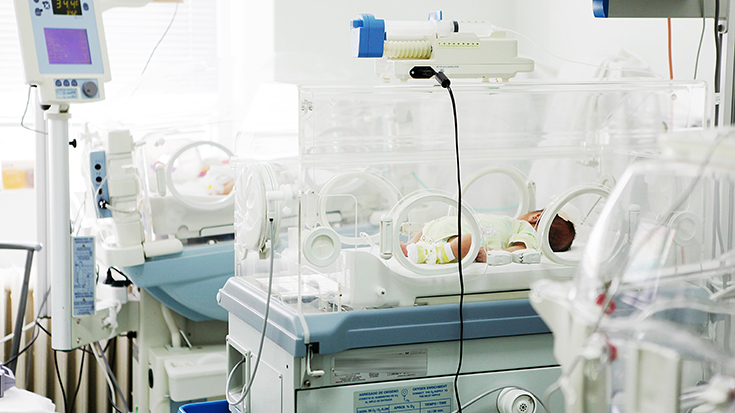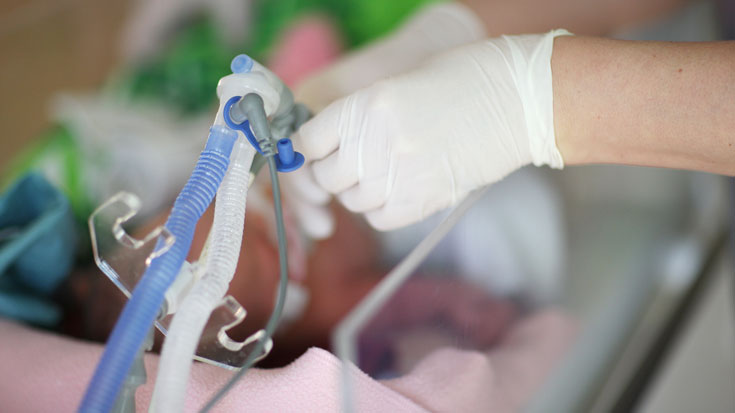
When infants are born with congenital abnormalities, they are often immediately transferred to another facility with specialized critical care units to accommodate their needs. As a result, the mom is left to recover in the delivery facility, with no ready access to her newborn.
Nemours Alfred I. duPont Hospital for Children and ChristianaCare in Delaware have implemented a new advanced delivery unit (ADU) that keeps these moms and their babies together throughout their hospital stay.
Respiratory therapists and other clinicians who work in the unit are known as the Stork Team, and together they make sure the newborns get the care they need while remaining under their mothers’ watchful eyes.
A Delaware first
“This program — the first of its kind in Delaware — started delivering babies with life-threatening, prenatally-diagnosed conditions in the fall of 2019,” said L’Tanya Pierce, MBA, RRT, RRT-NPS, AE-C, PICU clinical lead for respiratory care at Nemours Children’s in Wilmington. “Maternal risk factors are considered prior to accepting the mom for delivery, to ensure the safest experience for both the mom and baby.”
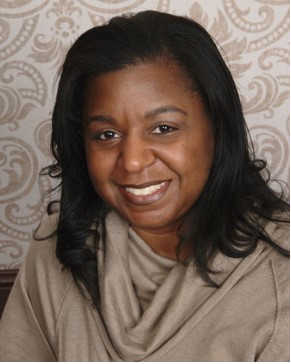 L’Tanya Pierce shares her hospital’s experience with an Advanced Delivery Unit.
L’Tanya Pierce shares her hospital’s experience with an Advanced Delivery Unit.The unit was many months in the making, as the obstetrical team at ChristianaCare worked closely with the neonatal team at Nemours Children’s to ensure a smooth process. In addition, the RT clinical lead in the NICU played a significant role, helping to plan the room set up and processes, and participating in multiple mock deliveries, codes, and simulations.
An intense debriefing session took place after each simulation, resulting in modifications to make the entire process more effective. Equipment, in particular, had to be adjusted to accommodate the trip from the delivery room — or operating room, in the case of a C-section — to the NICU or CICU.
Direct line of sight
The ADU is located at Nemours, and both the obstetrical team from ChristianaCare and the neonatal team from Nemours Children’s are in attendance throughout the deliveries. Delivery is led by the obstetrical team, with post-delivery interventions managed by pediatric subspecialists.
“The Advanced Delivery Unit is located between the NICU and CICU,” said Pierce. “It consists of two labor, delivery, recovery, and postpartum rooms. The rooms are big enough to accommodate two medical teams — one for the mother and one for the baby — without them being elbow to elbow.”
The mother maintains a direct line of sight to her baby at all times.
Infants accepted into the program suffer from a range of conditions, but some of the most common are cardiac anomalies, gastroschisis, spina bifida, hydrocephalus, osteogenesis imperfecta, skeletal dysplasia, omphaloceles, congenital diaphragmatic hernia, esophageal atresia/TEF, and suspected neuromuscular disorders.
All require immediate attention directly following birth.
Activating the team
The Stork Team is activated anytime a delivery involving a high-risk newborn is considered imminent.
“An email goes out to the Stork Team a few days before the mother’s admission date that lists all the team members that are assigned to the delivery,” explained Pierce. “This is also noted on the respiratory care department’s huddle board.” In addition, binders contain the baby’s progress, diagnoses, and any expectations and plans for the delivery.
Starting on the day of admission, the team huddles at 8:30 a.m. and 8 p.m. throughout the mother’s labor, or 8:30 a.m. if the delivery will be by C-section. The therapist on the team is responsible for setting up the delivery room or OR and handles much of the respiratory care needed post-delivery.
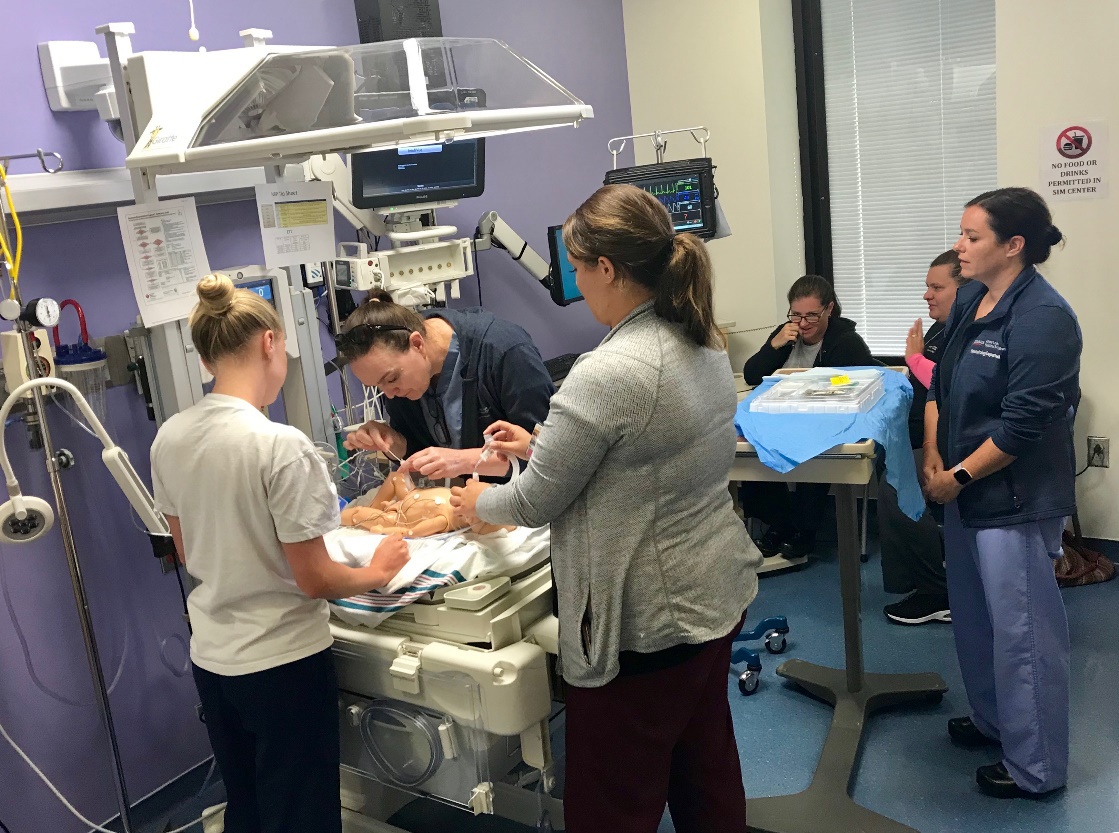 L’Tanya Pierce is pictured with her Stork Team teammates after the first delivery in the new unit in the fall of 2019.
L’Tanya Pierce is pictured with her Stork Team teammates after the first delivery in the new unit in the fall of 2019.Duties include preparing the bag/mask and T-piece set-up, the intubation supplies, suction (including blub suction), and the LMA. The therapist also obtains and prepares surfactant, if needed. After the baby is born, the RT places the pulse oximeter on the infant’s right hand and turns on the pulse oximeter.
If resuscitation is necessary, the RT places and ensures an adequate seal for mask CPAP. The therapist may also initiate T-piece ventilation with mask, with the FiO2 pre-determined based on the expected anomaly, and then monitor the infant for appropriate ventilation with chest rise. Further resuscitation following the NPR guidelines is performed as needed. The RT also assists with intubation and securing the ETT, along with transfer to the NICU or CICU.
The therapist participates in the debriefing that takes place following the delivery as well.
Two RRTs are assigned to the NICU around the clock, and one serves as the Stork Team member. In addition, one RRT is always in the cardiac OR or cath lab as well.
Life-changing care
Pierce believes the main advantage to an ADU is that babies who are prenatally diagnosed with congenital abnormalities that will require immediate care after birth are already where they need to be to get that care — and their mothers are right there with them.
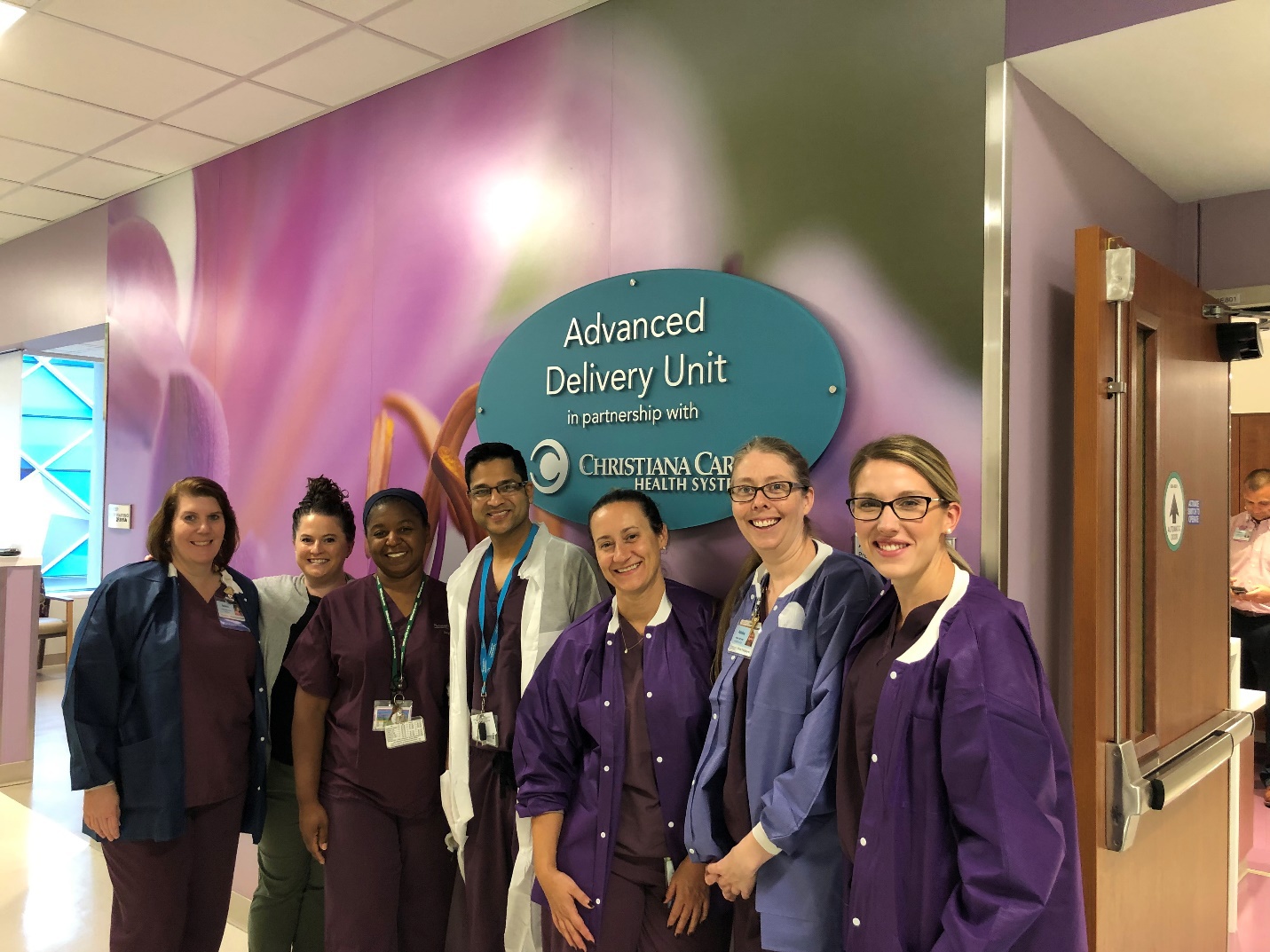 The interdisciplinary team, including Stork RT Virginia Pakradooni, RRT, RRT-NPS, third from the left, takes part in an ADU simulation.
The interdisciplinary team, including Stork RT Virginia Pakradooni, RRT, RRT-NPS, third from the left, takes part in an ADU simulation.“Transferring the babies can lead to additional health risks, and it can also mean mothers are being discharged earlier than their physicians would like,” she said. “By delivering the babies at Nemours, doctors could save hours of time — which could be life-changing — and moms are able to stay close to their babies after delivery and throughout hospitalization.”
For the mothers, that translates to less stress in what is already a stressful time in their lives.
“Moms can stay in the unit for as long as they need to recover from the pregnancy and delivery,” said Pierce.
Would she recommend an ADU to other children’s hospitals? That depends, said Pierce. First, you need to determine if there is a need for such a unit in your community. Second, both organizations that will be involved must have the same mission and vision, not to mention the ability to meet the needs of these high-risk patients.
“It takes years of collaboration, planning, and education to form a successful partnership,” she warned.
For Nemours, she continued, it was an easy decision because they had just such a partner in the expert obstetrical team at ChristianaCare.
“With this partnership, the family has the expertise of two premier institutions to manage the care of the mother and the baby,” she said. “We provide a unique service to the people within our community.”
If you have a similar situation, she believes going for an ADU is a “no-brainer.”
Great advice
Tanya Pierce has this advice for therapists interested in becoming a member of a Stork Team similar to the one at Nemours Children’s —
- Love what you do! Education and training are important. All team members should be NRP certified. Having a great interdisciplinary team that collaborates every step of the way is a must. Be a part of the planning from the beginning.
- Expect frequent updates and debriefing for modifications of practice. Every member of the Stork Team must participate in a quarterly simulation or live birth (two C-sections and two vaginal births a year).
- Communication and collaboration between the disciplines and the two organizations are extremely important. They are fully integrated from the initial diagnosis through post-intervention care.
Most infants — even many of those deemed high risk — will not need the services of an advanced delivery unit. But for those who do, it’s a concept that can improve safety and ensure the delivery of timely care, all while promoting the mother-child bond that is so important in the first days of life.
Email newsroom@aarc.org with questions or comments, we’d love to hear from you.







